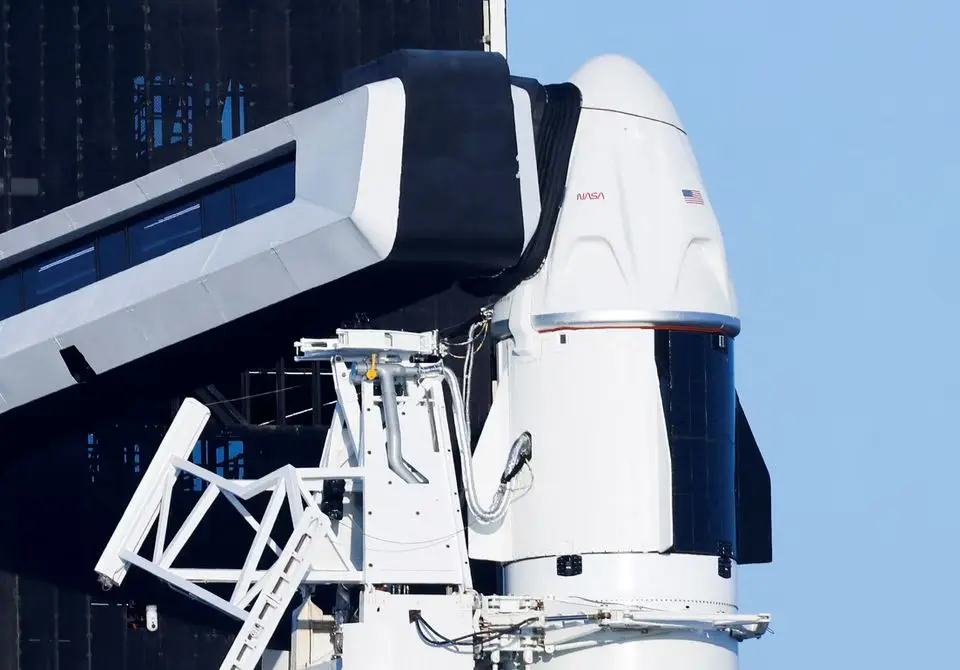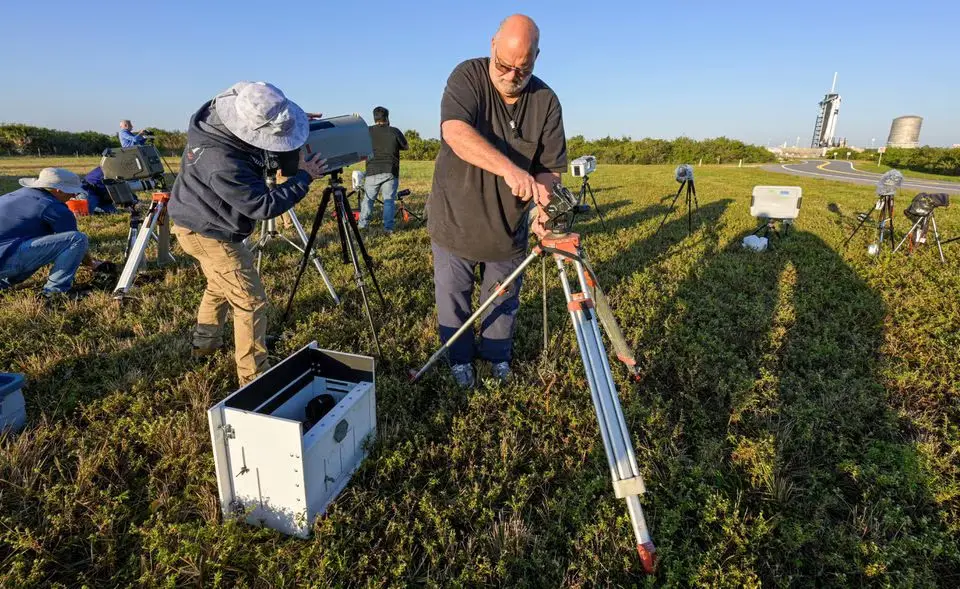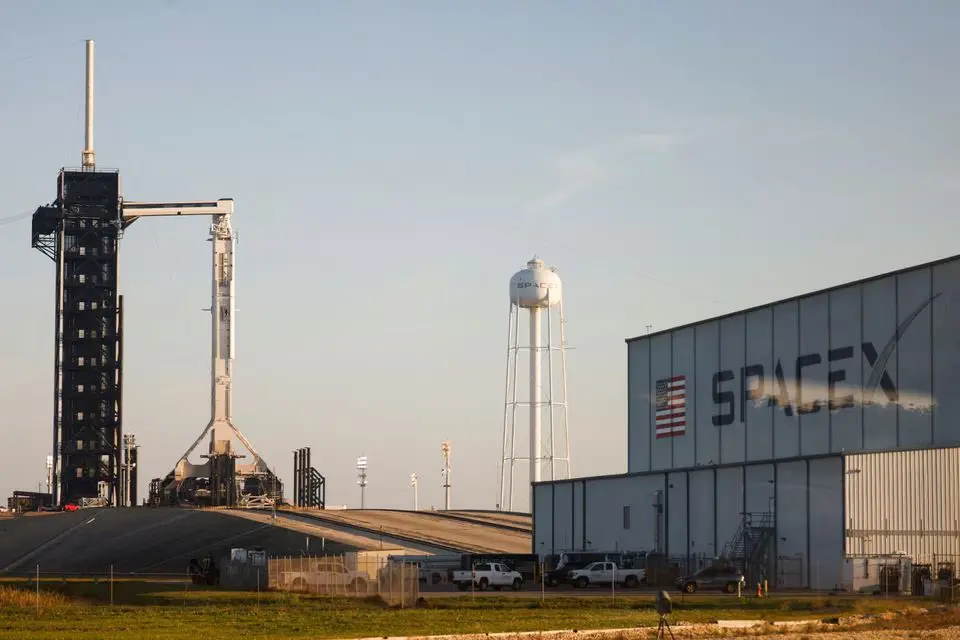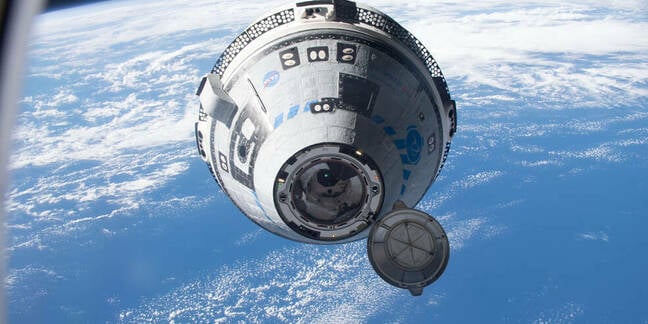Science
NASA and SpaceX launch Crew 6 Mission with UAE and Russian astronauts
(CTN News) – The next long-duration crew for the International Space Station, consisting of an astronaut from the United Arab Emirates, a Russian cosmonaut, and two NASA astronauts, was scheduled to be launched into orbit by Elon Musk’s rocket company SpaceX early on Monday.
Launch was scheduled for 1:45 a.m. EST (0645 GMT) from NASA’s Kennedy Space Center in Cape Canaveral, Florida, using a SpaceX launch vehicle consisting of a Falcon 9 rocket topped with a Crew Dragon capsule dubbed Endeavour that would be operated independently.
About 25 hours later, on Tuesday morning, the crew of four is expected to arrive at the International Space Station (ISS), where they will embark on a six-month mission in microgravity aboard the orbiting laboratory located approximately 250 miles (420 km) above Earth.
SpaceX, the commercial rocket company created by Musk, the billionaire CEO of electric car maker Tesla (TSLA.O) and social media platform Twitter, began transporting American astronauts to space in May 2020.

This trip, designated Crew 6, will be the sixth long-term ISS team flown by NASA aboard SpaceX.
On Saturday, NASA stated the launch readiness assessment was completed, and the flight was given the green light to go forward with liftoff as scheduled.
As of Sunday, “all systems and weather are looking excellent for launch,” Musk tweeted.
Stephen Bowen, 59, a former U.S. Navy submarine officer and mission commander of the newest ISS crew, has spent over 40 days in orbit across three shuttle flights and seven spacewalks.
For his part, Warren “Woody” Hoburg, an engineer and commercial pilot, has been selected as the first-time astronaut to pilot the Crew 6 mission.
The United Arab Emirates (UAE) sent Sultan Alneyadi, 41, to the International Space Station as part of the Crew 6 mission.
He is the first person from the UAE to travel to space and the first person from any Arab country to launch from American soil as part of a long-duration space station crew.
In 2019, a Russian spacecraft carried the United Arab Emirates first-ever astronaut into space.
Andrei Fedyaev, a Russian cosmonaut of the same age as Alneyadi, 41, is the fourth and final member of Crew 6. Fedyaev is an engineer and spaceflight novice like Alneyadi, and he is assigned as a mission specialist for the crew.

Despite heightened tensions between Washington and Moscow over Russia’s invasion of Ukraine, NASA and the Russian space agency Roscosmos struck a ride-sharing agreement in July, making Fedyaev the latest cosmonaut to fly on an American spacecraft.
The seven people living on the International Space Station (including three Americans from NASA, including commander Nicole Aunapu Mann, the first Native American woman to fly to space), three Russians, and a Japanese astronaut will be the first to welcome the Crew 6 crew when they arrive.
The International Space Station (ISS) has been continually run by a U.S.-Russian-led partnership that includes Canada, Japan, and 11 European countries. It is roughly the length of a football field.
The original Cold War conflicts between the United States and the Soviet Union in the 1950s and 1960s sparked the U.S.-Soviet space race. The outpost was partly planned to restore relations between Washington and Moscow after the Soviet Union’s fall.

Since Russia invaded Ukraine a year ago, the United States has imposed severe sanctions on Moscow and progressively increased military help to the Ukrainian government, putting NASA and Roscosmos’ cooperation to the test like never before.
Two recent incidents involving Russian spacecraft attached to the orbiting laboratory involved coolant leaks thought to have been caused by micrometeoroids, tiny grains of space rock, racing through space and striking the vessel at high velocity.
A Soyuz capsule carrying two cosmonauts and an astronaut to the International Space Station in September for a six-month mission that was originally scheduled to expire in March was a damaged Russian vehicle.
On Saturday, the space station was greeted by an empty Soyuz launched on Friday to return the crew home.
Related CTN News:
Apple First-Generation iPhone 2007 Fetches $63,000 At Auction

Science
NASA Switches Off Instrument On Voyager 2 Spacecraft To Save Power

NEW YORK — To save power, NASA turned off another scientific equipment on its long-running Voyager 2 spacecraft.
NASA Switches Off Instrument On the Spacecraft To Save Power
The space agency announced on Tuesday that 2’s plasma science instrument, meant to study the movement of charged atoms, was turned off in late September to allow the spacecraft to continue exploring for as long as possible, which is estimated to be into the 2030s.
NASA turned off a suite of instruments on Voyager 2 and its twin, Voyager 1, after exploring the gas giant planets in the 1980s. Both are currently in interstellar space or the region between stars. The plasma instrument on Voyager 1 stopped working years ago and was finally shut off in 2007.
The remaining four instruments on 2 will continue to collect data on magnetic fields and particles. Its mission is to investigate the regions of space beyond the sun’s protective sphere.
NASA Switches Off Instrument On Voyager 2 Spacecraft To Save Power
It launched in 1977, is the only spacecraft to have visited Uranus and Neptune. It is now more than 12 billion miles (19.31 billion kilometers) from Earth. 1 is more than 15 billion miles (24.14 billion kilometers) beyond Earth.
SOURCE | AP
Science
Hurricane Kirk Could Cause Dangerous Surf Conditions Along The US East Coast

MIAMI — Hurricane Kirk’s waves could generate life-threatening surf and rip current conditions this weekend throughout the United States East Coast, as well as in Bermuda, the Greater Antilles, and the Bahamas, according to forecasters.
Kirk was a Category 3 hurricane in the middle Atlantic Ocean that might grow further but was predicted to stay away from land, according to the Miami-based National Hurricane Center on Thursday.
Hurricane Kirk Could Cause Dangerous Surf Conditions Along The US East Coast
Kirk-generated swells were forecast to reach parts of the Leeward Islands on Friday, Bermuda and the Greater Antilles on Saturday, and the East Coast and the Bahamas on Sunday, according to the center.
No coastal watches or warnings were in effect. The major storm was around 1,130 miles (1,820 kilometers) east of the Leeward Islands, with maximum sustained winds of 125 mph (205 km/h).
Meanwhile, Tropical Storm Leslie formed late Wednesday in the eastern Atlantic and is expected to strengthen into a hurricane in the following days, forecasters said. It was also not considered a threat to the land.
Hurricane Kirk Could Cause Dangerous Surf Conditions Along The US East Coast
The storm was about 540 miles (870 kilometers) southwest of Cabo Verde’s southernmost tip, with maximum sustained winds of 45 mph (75 kph), according to the center.
The storms raged in the Atlantic as rescuers in the United States Southeast sought for missing persons after Hurricane Helene struck last week, leaving a trail of death and devastation.
SOURCE | AP
Science
NASA Sends First Manned Starliner Spacecraft to Space Station

NASA has announced astronauts Butch Wilmore and Suni Williams are safely in orbit on the first crewed flight test of Boeing’s Starliner spacecraft heading for the International Space Station.
As part of NASA’s Boeing Crew Flight Test, the astronauts launched a ULA (United Launch Alliance) Atlas V rocket from Space Launch Complex-41 at Cape Canaveral Space Force Station in Florida at 10:52 a.m. EDT Wednesday for an end-to-end test of the Starliner system.
“Two brave NASA astronauts are well on their way to this historic first test flight of a brand-new spacecraft,” stated NASA Administrator Bill Nelson. “Boeing’s Starliner represents a new era of American exploration. Human spaceflight is a risky endeavor, but it is worth it. It is an exciting time for NASA, our commercial partners, and the future of space exploration. “Go Starliner, Butch, and Suni!”
The flight test is part of NASA’s Commercial Crew Program and will help validate the transportation system, launch pad, rocket, spacecraft, in-orbit operations capabilities, and return to Earth with astronauts aboard as the agency prepares to certify Starliner for rotational missions to the space station. Starliner has already completed two uncrewed orbital missions, including a test to and from the space station, as well as a pad abort demonstration.

Boeing Starliner Makes Orbit
“With Starliner’s launch, separation from the rocket, and arrival in orbit, Boeing’s Crew Flight Test is right on track,” said Mark Nappi, vice president and program manager for Boeing’s Commercial Crew Program. “Everyone is focused on giving Suni and Butch a safe, comfortable, ride and performing a successful test mission from start to finish.”
Boeing’s mission control center in Houston will supervise a sequence of autonomous spacecraft maneuvers while Starliner is in flight. NASA teams will supervise space station activities from the Mission Control Center at the agency’s Johnson Space Center in Houston.
“Flying crew on Starliner represents over a decade of work by the Commercial Crew Program and our partners at Boeing and ULA,” said Steve Stich, Commercial Crew Program Manager at NASA’s Johnson Space Center in Houston. “For many of us, this is a career-defining occasion, ushering in a new crew transportation capacity for our agency and our country. We will take it one step at a time, putting Starliner through its paces and remaining watchful until Butch and Suni safely land back on Earth at the end of this test journey.”
At about 12:15 p.m., Starliner will dock autonomously to the forward-facing port of the station’s Harmony module. Thursday, June 6, and will remain at the orbital laboratory for almost a week.
Wilmore and Williams will help ensure that the spacecraft is functioning properly by testing the environmental control system, the displays and control system, and moving the thrusters, among other things, during flight.
Wilmore and Williams will join the Expedition 71 crew, which includes NASA astronauts Michael Barratt, Matt Dominick, Tracy C. Dyson, and Jeanette Epps, as well as Roscosmos cosmonauts Nikolai Chub, Alexander Grebenkin, and Oleg Kononenko.
NASA’s arrival and in-flight event coverage is as follows (all times Eastern and subject to change depending on real-time operations):
NASA Television channels will continue to broadcast the Starliner’s mission.
Thursday, June 6
9:30 a.m. – Arrival coverage begins on NASA+, the NASA app, and YouTube, and continues on NASA Television and the agency’s website.
12:15 p.m. – Targeted docking
2 p.m. – Hatch opening
2:20 p.m. – Welcome remarks
3:30 p.m. – Post-docking news conference at NASA Johnson with the following participants:
- NASA Associate Administrator Jim Free
- Steve Stich, manager, NASA’s Commercial Crew Program
- Jeff Arend, manager for systems engineering and integration, NASA’s International Space Station Office
- Mark Nappi, vice president and program manager, Commercial Crew Program, Boeing
Coverage of the post-docking news conference will air live on NASA+, NASA Television, the NASA app, YouTube, and the agency’s website.
To attend the post-docking briefing, U.S. media must contact the NASA Johnson newsroom at: jsccommu@mail.nasa.gov or 281-483-5111 by 1 p.m. Thursday, June 6. To join by phone, media must contact the NASA Johnson newsroom by 3 p.m. Thursday, June 6.
5:50 p.m. – NASA Administrator Bill Nelson, Deputy Administrator Pam Melroy, Associate Administrator Jim Free, Associate Administrator for Space Operations Ken Bowersox, and Johnson Space Center Director Vanessa Wyche will speak with Wilmore and Williams about their launch aboard the Starliner spacecraft.
Coverage of the Earth to space call will air live on NASA+, NASA Television, the NASA app, YouTube, and the agency’s website.
Saturday, June 8
8:50 a.m. – NASA astronauts Wilmore and Williams will provide a tour of Starliner.
Coverage of the in-orbit event will stream live on NASA+, NASA Television, the NASA app, YouTube, and the agency’s website.
Monday, June 10
11 a.m. – Williams will speak to students from Sunita L. Williams Elementary School in Needham, Massachusetts, in an event aboard the space station.
Coverage of the Earth to space call will air live on NASA+, NASA Television, the NASA app, YouTube, and the agency’s website.
Tuesday, June 11
3:15 p.m. – Wilmore will speak to students from Tennessee Tech University in an event aboard the space station.
Coverage of the Earth to space call will air live on NASA+, NASA Television, the NASA app, YouTube, and the agency’s website.
-

 News3 years ago
News3 years agoLet’s Know About Ultra High Net Worth Individual
-
Entertainment2 years ago
Mabelle Prior: The Voice of Hope, Resilience, and Diversity Inspiring Generations
-

 Health4 years ago
Health4 years agoHow Much Ivermectin Should You Take?
-

 Tech2 years ago
Tech2 years agoTop Forex Brokers of 2023: Reviews and Analysis for Successful Trading
-

 Lifestyles3 years ago
Lifestyles3 years agoAries Soulmate Signs
-

 Movies2 years ago
Movies2 years agoWhat Should I Do If Disney Plus Keeps Logging Me Out of TV?
-

 Health3 years ago
Health3 years agoCan I Buy Ivermectin Without A Prescription in the USA?
-

 Learning3 years ago
Learning3 years agoVirtual Numbers: What Are They For?
